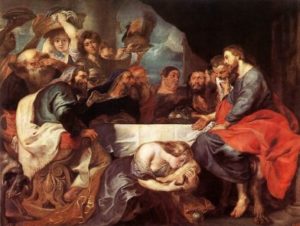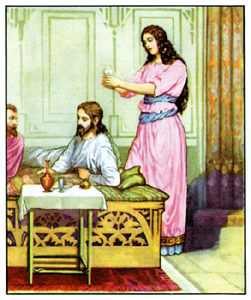Day 4: The Anointing, by Peter Paul Rubens
Art: In the midst of the crowd, Mary Magdala anoints Yeshua.Notice the faces of the onlookers, and the faces of Yeshua and Magdala.
Devotional: What a picture of love and devotion! Mary doesn’t care what the others think; she is absorbed by her love for Yeshua. She fills the role of the anointing priestess, preparing Yeshua for his death, descent into hell and resurrection. Yeshua said her act would be remembered forever,thus drawing attention to the significance of it. [Katia inserts: There are two actions in Yeshua’s life that he says will be remembered forever. One is this anointing, the other is when at the last supper he says, “Do this in remembrance of me,” regarding the bread and wine of eucharist. It is fascinating that there is a sacramental action –“ritual”that can be extrapolated from each of these events. One is to be done “in memory of her” (Yeshua’s actual words in Matthew and Mark at the anointing scene) and the other ritual, the mass, the eucharist, is done”in remembrance of” him. The mainstream Church has done anointings for centuries, but only of the sick. Such anointings are not done in her memory, nor done as often as the eucharist ritual is re-enacted. Both are part of the Hieros Gamos/Sacred Marriage rites of Esoteric Christianity.] What does the anointing teach you?

Peter Paul Rubens, 1618
Note that in the two oldest gospels, Mark and Matthew, she anoints Yeshua’s head, not his feet. Only in Luke is it his feet only. John implies that both are anointed, and that is most likely. In keeping with ancient anointing rituals she would have started at his head as pictured right, probably anointed his ears, eyes and backs of his hands, and then his feet. By that time she was surely caught up in the anguish of the ancient rite she was performing — “she has anticipated my burial” he says — and it is no wonder she was crying by that time. Thus the crying on his feet and wiping with hair. In Hebrew, the word Messiah literally means, “the anointed one. ” In order to be the messiah, he must have been anointed at some point in his life. There are only four stories told in all four Gospels. Jesus’ baptism, the Feeding of the Five Thousand, the Crucifixion/Resurrection story and the Anointing by a Woman. His birth is only in two gospels, as is the Lord’s Prayer. The establishment of the eucharist is in 3. The anointing was so important that it had to be included in each gospel — yet we are often taught a distorted version of this story, that the woman was an unclean sinner, etc. Actually only Luke calls her a sinner. The other three gospels do not defame her in such a way. In those days there were dozens of words for sinner,and interestingly, the meaning of the word Luke uses for sinner is more like “civil transgressor, ” one who didn’t pay their taxes or had unpaid parking tickets or something (!). So maybe Luke was saying she was an anti-government sympathizer or anarchist, not a dirty sinner.
anointed, and that is most likely. In keeping with ancient anointing rituals she would have started at his head as pictured right, probably anointed his ears, eyes and backs of his hands, and then his feet. By that time she was surely caught up in the anguish of the ancient rite she was performing — “she has anticipated my burial” he says — and it is no wonder she was crying by that time. Thus the crying on his feet and wiping with hair. In Hebrew, the word Messiah literally means, “the anointed one. ” In order to be the messiah, he must have been anointed at some point in his life. There are only four stories told in all four Gospels. Jesus’ baptism, the Feeding of the Five Thousand, the Crucifixion/Resurrection story and the Anointing by a Woman. His birth is only in two gospels, as is the Lord’s Prayer. The establishment of the eucharist is in 3. The anointing was so important that it had to be included in each gospel — yet we are often taught a distorted version of this story, that the woman was an unclean sinner, etc. Actually only Luke calls her a sinner. The other three gospels do not defame her in such a way. In those days there were dozens of words for sinner,and interestingly, the meaning of the word Luke uses for sinner is more like “civil transgressor, ” one who didn’t pay their taxes or had unpaid parking tickets or something (!). So maybe Luke was saying she was an anti-government sympathizer or anarchist, not a dirty sinner.
Easy Lab Report Form
Contemplation Lab MainPage
1 2 3 4 5 6 7 8 9 10 11 12 13 14 15

